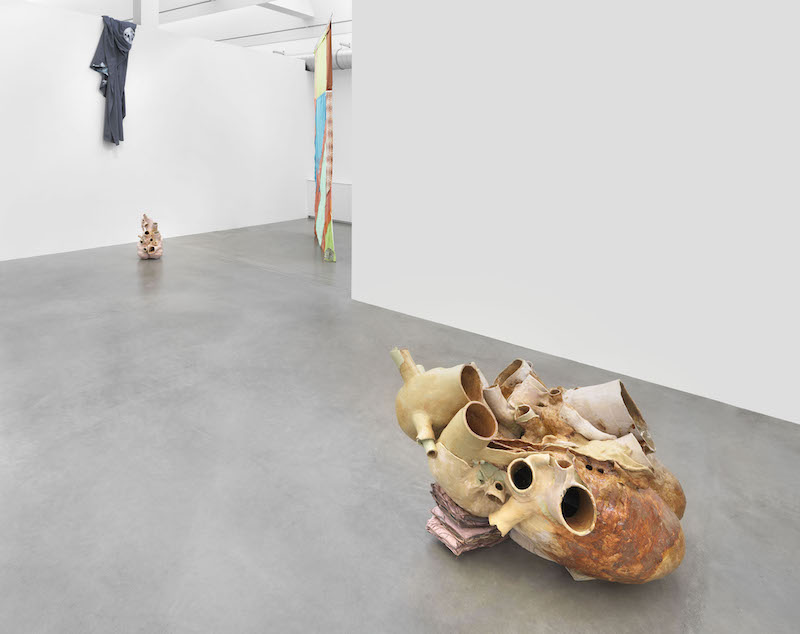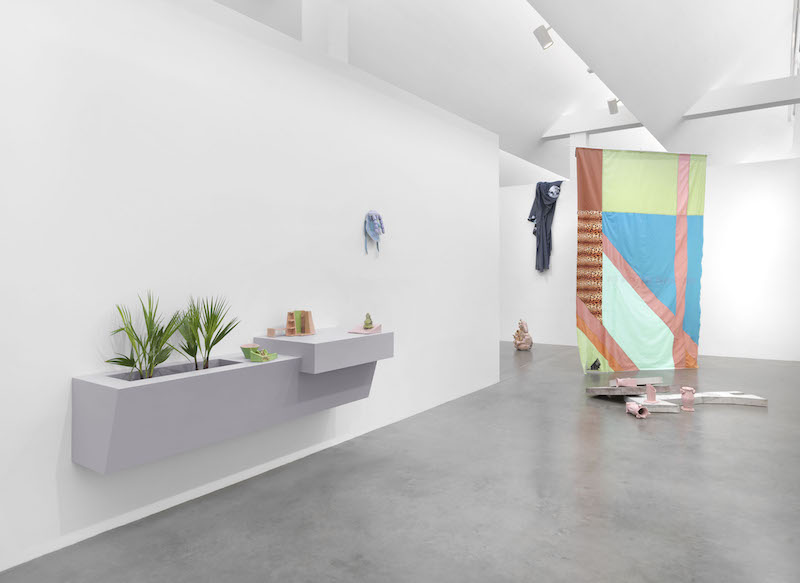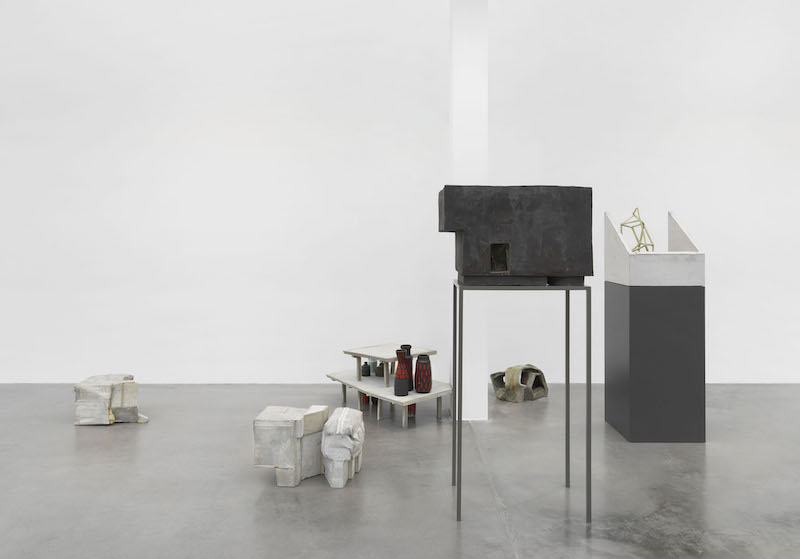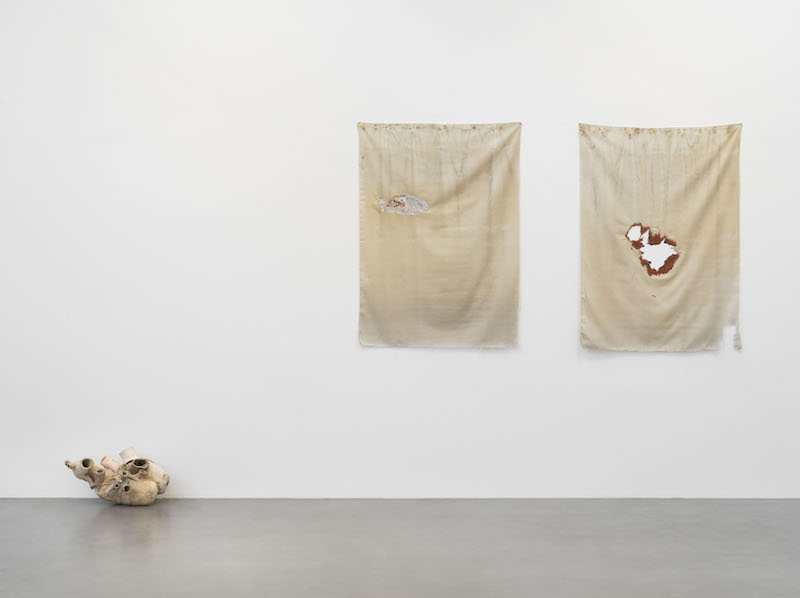by Elizabeth Schippers // May 12, 2020
Isa Melsheimer’s work is made up of an agglomeration of discourses surrounding the man-made world and the organic world and exposes underlying assumptions about the centering of human agency. Her work primarily explores architectural and urban topics, focussing on modernist and postmodernist architecture and its complex relationships to the human subject and nature. A collection of her most recent works, ‘Der unerfreuliche Zustand der Textur’ (Predicament of Texture) is currently exhibited in the Maschinenhaus M2 at the KINDL – Centre for Contemporary Art.

Isa Melsheimer: ‘Der unerfreuliche Zustand der Textur,’ Installation view, Maschinenhaus M2, KINDL – Centre for Contemporary Art, Berlin // Photo: Jens Ziehe, 2020
The exhibition space consists of a few open areas, separated from each other only by angled walls and hung tapestries. Three whale hearts, spread throughout the gallery, dominate our initial experience of the show. The two smaller ceramic hearts, ‘Walherz (Squish)’ (2018) and ‘Walherz (Jordan)’ (2018), are almost accessories to the central, giant ceramic piece ‘Walherz’ (2018), the texture and chromaticity of which alternates between a raw, fleshy earth tone, a glazed vase-like surface, and almost metallic tubes. This work is a result of Melsheimer’s fellowship on the island of Fogo, off the coast of Newfoundland, in 2017. During the residency, Melsheimer was able to pursue her artistic research into the life of marine mammals, which led her to observe the journey of a 300-kilogram heart of a blue whale—found beached on the coast of Newfoundland—to Brandenburg, where it would be plastinated for a Canadian museum. The ceramic whale heart critiques the agency of the human subject as it freely displaces these magnificent creatures, even after death. During her stay, Melsheimer primarily engaged with the island in terms of its ecological circumstances and the effects of human interference, resulting in phenomena like overfishing and global warming.

Isa Melsheimer: ‘Der unerfreuliche Zustand der Textur,’ Installation view, Maschinenhaus M2, KINDL – Centre for Contemporary Art, Berlin // Photo: Jens Ziehe, 2020
During her residency on Fogo Island, Melsheimer came into contact with the writing of Donna Haraway, a well-known feminist scholar whose work explores the possibility for decentering human agency in favour of a multi-species approach to agency and power structures. Haraway became famous for her ‘Cyborg Manifesto,’ in which she uses the cyborg as a figure of resistance, exploring its potential to engage in fusions, expand on dangerous possibilities and transgress boundaries. The cyborg is used here to question the tenability of binary distinctions like human and inhuman, male and female, and to highlight the problem with engaging in a privileging of one aspect of the binary as justification for repressing the non-privileged other. Through the figure of the cyborg, Haraway draws attention to the inherent instability of these binaries as they are manifested in contemporary society.
Haraway later expanded on this work by engaging with kinship among multiple species, further destabilising the binaries between human and organic matter. In her book ‘Staying with the Trouble,’ Haraway critiques our human-centred epoque, and encourages us to think of the world in a manner that encompasses all dynamics, forces and powers of which people are a part, including but not limited to animals, plants, machines, etc. She names this era the “Chthulucene,” and it is primarily from this multi-species approach that Melsheimer pulls when developing many of the works in ‘Der unerfreuliche Zustand der Textur.’ Works such as ‘Afterlife’ (2019) and ‘Peene Valley’ (2019) consist of cubic architecture and plant or animal shapes, fused together in a melting pot of organic and constructed material, proposing an alternative way of looking at architecture and design without creating a binary with nature. Seeking out these “new relationships,” as Haraway describes them, is central to Melsheimer’s work, especially insofar as she engages with modern and postmodern architecture, and it is this very discourse that creates a coherence among the various works exhibited in this show.

Isa Melsheimer: ‘Der unerfreuliche Zustand der Textur,’ Installation view, Maschinenhaus M2, KINDL – Centre for Contemporary Art, Berlin // Photo: Jens Ziehe, 2020
Aside from ceramic interpretations of the biological sphere, Melsheimer also includes real organic material in her recent work. For ‘Wardscher Kasten (Fogo Island)’ (2018), Melsheimer used seeds collected on Fogo Island to create two miniature biotopes. This work reflects on the mobile greenhouses developed by Nathaniel Bagshaw Ward in 1830, which were used to transport plants from distant colonies to England. The condensation on the glass walls allowed the plants to grow without any human interference. The self-sustaining greenhouse is set in stark contrast with the colonial practices that necessitated its development: the human interference present in taking seeds from its native ground, put on a human-made ship to sail it to colonial land. The relationship between human and nature is defined by the human subject, and we have defined it as a hierarchical one. With ‘Wardscher Kasten (Fogo Island)’ (2018), Melsheimer brings these unbalanced dynamics to our attention.
Melsheimer’s art follows Haraway’s call to actively seek possibilities for recuperation, especially as we are learning the great depths of the trouble we face. In her exploration of the possibilities for new, inter-species relationships in our current era, Melsheimer proposes a way of moving forward in contemporary times through invention, collaboration, exploration and play.
Exhibition Info
KINDL – CENTRE FOR CONTEMPORARY ART
Isa Melsheimer: ‘Der unerfreuliche Zustand der Textur (Predicament of Texture)’
Exhibition: Mar. 22 – July 05, 2020
Maschinenhaus M2, Am Sudhaus 3, 12053 Berlin, click here for map

Isa Melsheimer: ‘Der unerfreuliche Zustand der Textur,’ Installation view, Maschinenhaus M2, KINDL – Centre for Contemporary Art, Berlin // Photo: Jens Ziehe, 2020


























